
SEAWAY SHIPPING AGENCY SDN BHD As a renowned international NVOCC freight forwarder, we specialized in all aspect of international freight forwarding, logistic, linking worldwide with many counterparts and affiliates within the globe.
We able to source competitive sea freight charges, provide reliable services from shipping lines and most of all have regular interval with shortest time of arrival.
Being a NVOCC Freight Forwarder, we provide total logistics support for our valuable customers


Business logistics is a relatively new field in the study of business decision making, when compared with the traditional fields of study such as operations management, marketing, finance, human resources management.
Although businesses have been involved always with the activities that are now the domain of “business logistics” the benefits of coordination of logistics activities in business and the need to train the managers in managing a coordinated business logistics set up in their own firm gave an impetus to the separate study.
One definition of business logistics speaks of “having the right item in the right quantity at the right time at the right place for the right price in the right condition to the right customer”
Revolution of Business Logistics
a) Poist Classification of Development of Logistics
Poist, R.F. [1986] sees three eras in the development of the subject and practice of logistics.
In each of the eras the emphasis of application and study of logistics systems has changed.
| Poist: Classification of Development of Logistics | ||
| Era | Time Period | Emphasis |
| a. Pre – Logistics | Pre-1950s | Transportation |
| b. Logistics | 1950s, 1960s, 1970s | Logistics |
| c. Neo – Logistics | 1980s and beyond | Enterprise |
b) Balou Classification
Ballou, R. H. [1985] gives another account of the genesis of the subject Business Logistics and different eras and approaches.
His classification is as follow:
| Balou Classification | |
| Era | Time Period |
| a. Pre – 1950s | Dormant years |
| b. 1950s – 1970 | The development years |
| c. 1970s to present | The takeoff years |
c) Davis and Mandrodt Eras
Davis, F.W. Jr and Mandrodt, K.B., [1991] try to classify the business management historical eras:
| Davis and Mandrodt Classification | |
| Era | Time Period |
| a. Production era | Industrial revolution to end of 1800s |
| b. Distribution era | Early 20th century to the end of World War II |
| c. Marketing era | End of World War II to mid – 1970. |
| d. Quality era | Mid – 1970s to end of 1980s. |
| e. Service era | Present with de-industrialisation of the advanced Western economies. |
Our coverage of Business Logistics Activities
i) Core Logistics Activities
b) Stock Management
d) Transportation
a) Warehousing
b) Purchasing
c) Information acquisition and maintenance
d) Materials handling
e) Protection
f) Production scheduling
| DRY CARGO CONTAINERS | DIMENSIONS | |||||||||
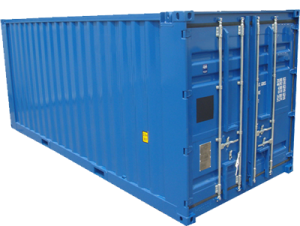 |
Type | Container Weight | Interior Measurement | Door Open | ||||||
| Gross (kg) |
Tare (kg) |
Net (kg) |
Length (m) |
Width (m) |
Height (m) |
Capacity (m) |
Width (m) |
Height (m) |
||
| 20 ft | 24,000 | 2,370 | 21,630 | 5.898 | 2.352 | 2.394 | 33.200 | 2.343 | 2.280 | |
| 40 ft | 30,480 | 4,000 | 26,480 | 12.031 | 2.352 | 2.394 | 67.740 | 2.343 | 2.280 | |
* CHARACTERISTICS
Manufactured from either Aluminium or steel, they are suitable for most types of cargo / general cargo. Aluminium containers have a slightly larger payload than steel, and steel containers have a slightly larger Internal Cube.
| REFRIGERATED CONTAINERS | DIMENSIONS | |||||||||
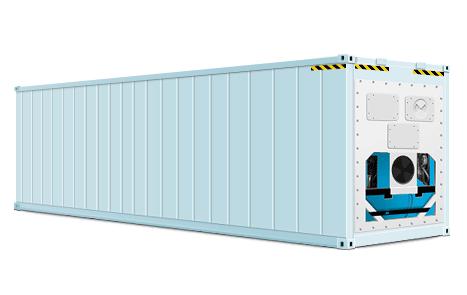 |
Type | Container Weight | Interior Measurement | Door Open | ||||||
| Gross (kg) |
Tare (kg) |
Net (kg) |
Length (m) |
Width (m) |
Height (m) |
Capacity (m) |
Width (m) |
Height (m) |
||
| 20 ft | 24,000 | 3,050 | 20,950 | 5.449 | 2.290 | 2.244 | 26.700 | 2.276 | 2.261 | |
| 40 ft | 30,480 | 4,520 | 25,960 | 11.690 | 2.250 | 2.247 | 57.100 | 2.280 | 2.205 | |
* CHARACTERISTICS
Recommended for delicate cargo. Bottom-air delivery system ensures refrigerated cargo reaches its destination in optimum condition.
| OPEN TOP CONTAINERS | DIMENSIONS | |||||||||
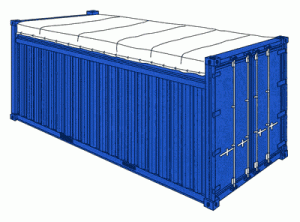 |
Type | Container Weight | Interior Measurement | Door Open | ||||||
| Gross (kg) |
Tare (kg) |
Net (kg) |
Length (m) |
Width (m) |
Height (m) |
Capacity (m) |
Width (m) |
Height (m) |
||
| 20 ft | 24,000 | 2,580 | 21,420 | 5.629 | 2.212 | 2.311 | 32.000 | 2.330 | 2.263 | |
| 40 ft | 30,480 | 4,290 | 26,190 | 11.763 | 2.212 | 2.311 | 65.400 | 2.330 | 2.263 | |
* CHARACTERISTICS
Allowing cargo to be loaded from the top, open top containers are particularly suitable for bulky cargo such as machinery. They are fitted with a PVC tarpaulin cover and attachable bows with cable sealing devices. The container doors can be removed to make the stuffing of cargo more convenient. Manufactured from steel.
| FLAT RACK CONTAINERS | DIMENSIONS | |||||||
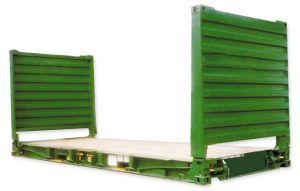 |
Type | Container Weight | Interior Measurement | |||||
| Gross (kg) |
Tare (kg) |
Net (kg) |
Length (m) |
Width (m) |
Height (m) |
Capacity (m) |
||
| 20 ft | 30,480 | 2,900 | 27,580 | 5.624 | 2.236 | 2.234 | 27.900 | |
| 40 ft | 34,000 | 5,870 | 28,130 | 11.786 | 2.236 | 1.968 | 51.900 | |
* CHARACTERISTICS
Flatracks are especially suited to heavy loads or cargo that needs loading from the top or sides, such as pipes and machinery. There are collapsible and non-collapsible containers with or without walls. Manufactured from steel.
| GARMENT CONTAINERS | DIMENSIONS | |||||||||
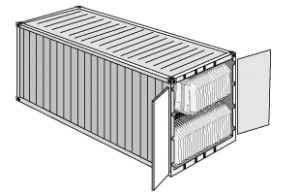 |
Type | Container Weight | Interior Measurement | Door Open | ||||||
| Gross (kg) |
Tare (kg) |
Net (kg) |
Length (m) |
Width (m) |
Height (m) |
Capacity (m) |
Width (m) |
Height (m) |
||
| 20 ft | 24,000 | 2,240 | 21,760 | 5.898 | 2.352 | 2.394 | 33.200 | 2.343 | 2.280 | |
| 40 ft | 30,480 | 3,885 | 26,595 | 12.031 | 2.352 | 2.394 | 67.740 | 2.343 | 2.280 | |
* CHARACTERISTICS
Use for all kinds of garment. The containers are specially designed for garment product and related industry.
There are some options of using a string or bar system or a combination of both. The containers allow increased flexibility, greater load Internal Capacity and savings on transportation and handling cost.
| HIGH CUBE CONTAINERS | DIMENSIONS | |||||||||
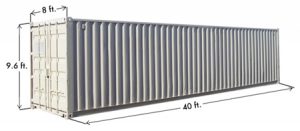 |
Type | Container Weight | Interior Measurement | Door Open | ||||||
| Gross (kg) |
Tare (kg) |
Net (kg) |
Length (m) |
Width (m) |
Height (m) |
Capacity (m) |
Width (m) |
Height (m) |
||
| 40 ft | 30,480 | 3,980 | 26,500 | 12.031 | 2.352 | 2.698 | 76.300 | 2.340 | 2.585 | |
| 45 ft | 30,480 | 4,800 | 25,680 | 13.544 | 2.352 | 2.698 | 86.000 | 2.340 | 2.585 | |
* CHARACTERISTICS
With high cube containers, you gain extra foot in height compared with general-purpose containers. Ideal for light, voluminous cargo or bulky cargo. These extra volume containers come in steel and aluminium.
Note: For reference only.
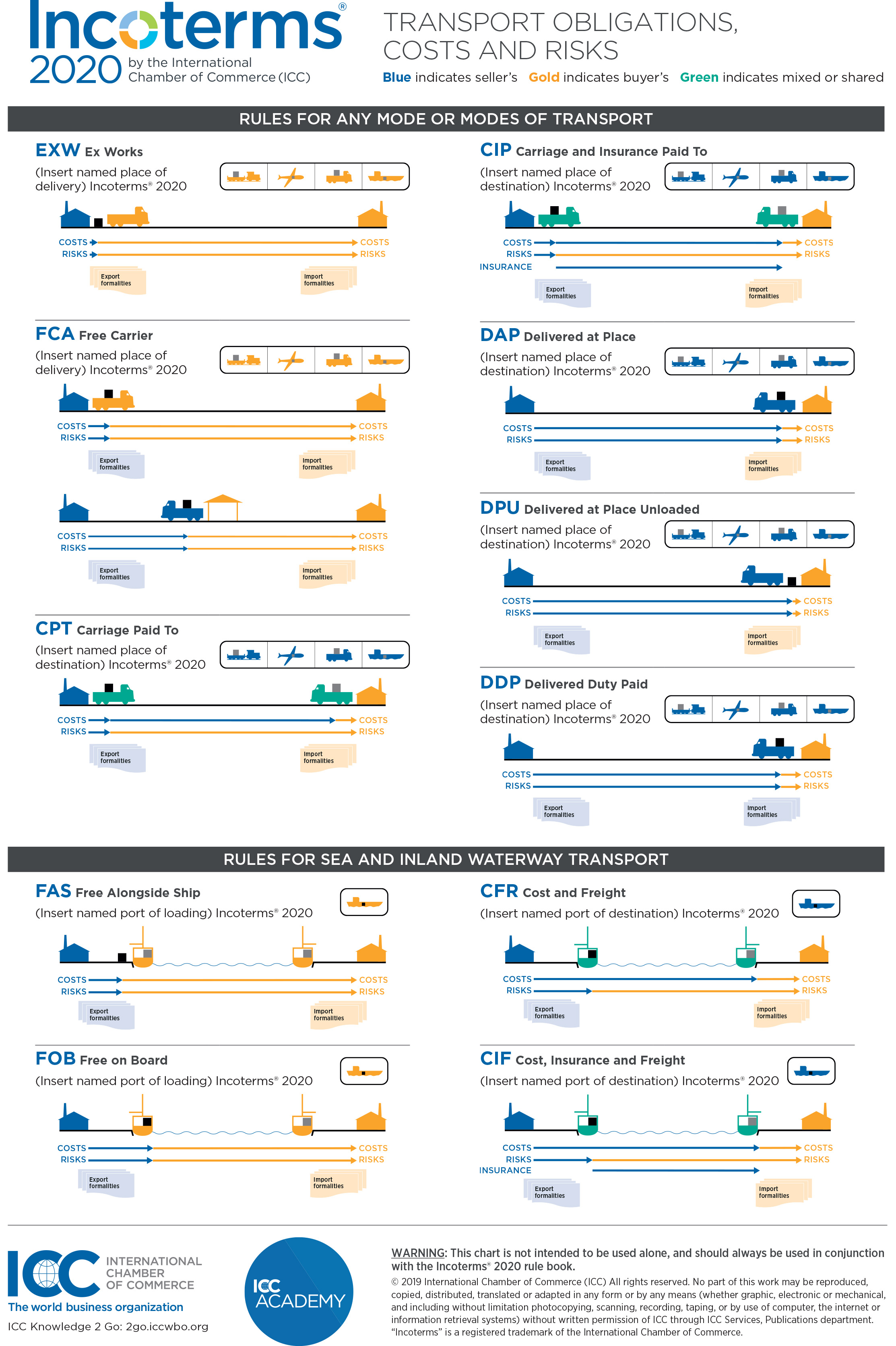
(Source from International Chamber of Commerce)
* There are actually two FCA terms: FCA Seller’s premises where the seller is responsible only for loading the goods and not responsible for inland freight; and FCA Named Place (International Carrier) where the seller is responsible for Inland Freight.
** INCOTERM RULES ARE NOT LAW AND WILL NOT RESOLVE ALL PROBLEMS IN TRADE. ABOVE DEFINITIONS ARE TO BE USED AS A GUIDELINE ONLY.
EXW
“Ex works” means that the seller delivers when he places the goods at the disposal of the buyer at the seller’s premises or another named place (i.e. works, factory, warehouse, etc.) not cleared for export and not loaded on any collecting vehicle.
This term thus represents the minimum obligation for the seller, and the buyer has to bear all costs and risks involved in taking the goods from the seller’s premises.
However, if the parties wish the seller to be responsible for the loading of the goods on departure and to bear the risks and all the costs of such loading, this should be made clear by adding explicit wording to this effect in the contract of sale. This term should not be used when the buyer cannot carry out the export formalities directly or indirectly. In such circumstances, the FCA term should be used, provided the seller agrees that he will load at his cost and risk.
FCA
“Free Carrier” means that the seller delivers the goods, cleared for export, to the carrier nominated by the buyer at the named place. It should be noted that the chosen place of delivery has an impact on the obligations of loading and unloading the goods at that place. If delivery occurs at the seller’s premises, the seller is responsible for loading. If delivery occurs at any other place, the seller is not responsible for unloading.
This term may be used irrespective of the mode of transport, including multimodal transport.
“Carrier” means any person who, in contract of carriage, undertakes to perform or to procure the performance of transport by rail, road, air, sea, inland waterway or by a combination of such modes.
If the buyer nominates a person other than a carrier to receive the goods, the seller is deemed to have fulfilled his obligation to deliver the goods when they are delivered to that person.
FAS
“Free Alongside Ship” means that the seller delivers when the goods are placed alongside the vessel at the named port of shipment. This means that the buyer has to bear all costs and risks of loss of or damage to the goods from that moment.
The FAS term requires the seller to clear the goods for export.
THIS IS A REVERSAL FROM PREVIOUS INCOTERMS VERSIONS WHICH REQUIRED THE BUYER TO ARRANGE FOR EXPORT CLEARANCE.
However, if the parties wish the buyer to clear the goods for export, this should be made clear by adding explicit wording to this effect in the contract of sale.
This term can be used only for sea or inland waterway transport.
FOB
“Free on Board” means that the seller delivers when the goods pass the ship’s rail at the named port of shipment. This means that the buyer has to bear all costs and risks of loss of or damage to the goods from that point.The FOB term requires the seller to clear the goods for export. This term can be used only for sea or inland waterway transport. If the parties do not intend to deliver the goods across the ship’s rail, the FCA term should be used.
CFR
“Cost and Freight” means that the seller delivers when the goods pass the ship’s rail in the port of shipment.
The seller must pay the costs and freight necessary to bring the goods to the named port of destination BUT the risk of loss of or damage to the goods, as well as any additional costs due to events occurring after the time of delivery, are transferred from the seller to the buyer.
The CFR term requires the seller to clear the goods for export.
This term can be used only for sea and inland waterway transport. If the parties do not intend to deliver the goods across the ship’s rail, the CPT term should be used.
CIF
“Cost, Insurance and Freight” means that the seller delivers when the goods pass the ship’s rail in the port of shipment.
The seller must pay the costs and freight necessary to bring the goods to the named port of destination BUT the risk of loss of or damage to the goods, as well as any additional costs due to events occurring after the time of delivery, are transferred from the seller to the buyer. However, in CIF the seller also has to procure marine insurance against the buyer’s risk of loss of or damage to the goods during the carriage.
Consequently, the seller contracts for insurance and pays the insurance premium. The buyer should note that under the CIF term the seller is required to obtain insurance only on minimum cover. Should the buyer wish to have the protection of greater cover, he would either need to agree as much expressly with the seller or to make his own extra insurance arrangements.
The CIF term requires the seller to clear the goods for export.
This term can be used only for sea and inland waterway transport. If the parties do not intend to deliver the goods across the ship’s rail, the CIP term should be used.
CPT
“Carriage paid to …” means that the seller delivers the goods to the carrier nominated by him but the seller must in addition pay the cost of carriage necessary to bring the goods to the named destination.
This means that the buyer bears all risks and any other costs occurring after the goods have been so delivered.
“Carrier” means any person who, in a contract of carriage, undertakes to perform or to procure the performance of transport, by rail, road, air, sea, inland waterway or by a combination of such modes.
If subsequent carriers are used for the carriage to the agreed destination, the risk passes when the goods have been delivered to the first carrier.
The CPT term requires the seller to clear the goods for export.
This term may be used irrespective of the mode of transport including multimodal transport.
CIP
“Carriage and Insurance paid to …” means that the seller delivers the goods to the carrier nominated by him, but the seller must in addition pay the cost of carriage necessary to bring the goods to the named destination. This means that the buyer bears all risks and any additional costs occurring after the goods have been so delivered. However, in CIP the seller also has to procure insurance against the buyer’s risknof loss of or damage to the goods during the carriage.
Consequently, the seller contracts for insurance and pays the insurance premium.
The buyer should note that under the CIP term the seller is required to obtain insurance only on minimum cover. Should the buyer wish to have the protection of greater cover, he would either need to agree as much expressly with the seller or to make his own extra insurance arrangements.
“Carrier” means any person who, in a contract of carriage, undertakes to perform or to procure the performance if transport, by rail, road, air, sea, inland waterway or by a combination of such modes.
If subsequent carriers are used for the carriage to the agreed destination, the risk passes when the goods have been delivered to the first carrier.
The CIP term requires the seller to clear the goods for export.
This term may be used irrespective of the mode of transport, including multimodal transport.
DAT
“Delivered at Terminal” means that the seller delivers when the goods, once unloaded from the arriving means of transport, are placed at the disposal of the buyer at a named terminal at the named port or place of destination. “Terminal” includes any place, whether covered or not, such as a quay,warehouse, container yard or road, rail of air cargo terminal. The seller bears all risks involved in bringing the goods to and unloading them at the terminal at the named port or place of destination.
DAP
“Delivered duty unpaid” means that the seller delivers the goods to the buyer, not cleared for import, and not unloaded from any arriving means of transport at the named place of destination. The seller has to bear the costs and risks involved in bringing the goods thereto, other than, where applicable, any “duty” (which term includes the responsibility for and the risks of the carrying out of customs formalities, and the payment of formalities, customs duties, taxes and other charges) for import in the country of destination. Such “duty” has to be borne by the buyer as well as any costs and risks caused by his failure to clear the goods for import in time.
However, if the parties wish the seller to carry out customs formalities and bear the costs and risks resulting therefrom as well as some of the costs payable upon import of the goods, this should be made clear by adding explicit wording to this effect in the contract of sale.
This term may be used irrespective of the mode of transport but when delivery is to take place in the port of destination on board the vessel or the quay (wharf), the DES or DEQ terms should e used.
DDP
“Delivered duty paid” means that the seller delivers the goods to the buyer, cleared for import, and not unloaded from any arriving means of transport at the named place of destination. The seller has to bear all the costs and risks involved in bringing the goods thereto including, where applicable, any “duty” (which term includes the responsibility for and the risk of the carrying out of customs formalities and the payment of formalities, customs duties, taxes and other charges) for import in the country of destination.
Whilst the EXW term represents the minimum obligation for the seller, DDP represents the maximum obligation.
This term should bot be used if the seller is unable directly or indirectly to obtain the import licence.
However, if the parties wish to exclude from the seller’s obligations some of the costs payable upon import of the goods (such as value-added tax: VAT), this should be made clear by adding explicit wording to this effect in the contract of sale.
If the parties wish the buyer to bear all risks and costs of the import, the DDU term should be used.
This term may be used irrespective of the mode of transport but when delivery is to take place in the port of destination on board the vessel or on the quay (wharf), the DES or DEQ terms should be used.
Tel : +607 350 7728
Fax : +607 361 2771
Email : sales@seawayshipping.com.my
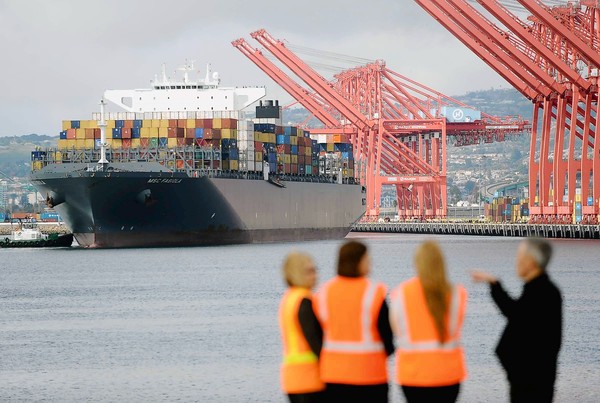



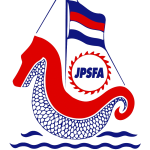

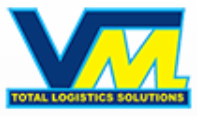
Vertex Mission delivers a full range of logistics and supply chain management solutions rooted in the power of efficiency. As your dependable logistics partner, we will sit down with you at the beginning of the project to understand your unique needs and challenges, and then propose a tailor-made solution designed to help you outpace the competition.
To take our efficiency to the next level, we have implemented an e-commerce enabled IT gateway complete with a logistics tracking system. This provides our clients with a convenient way to request for transportation and a full visibility to their shipment status, eliminating worry and the hassle of having to find out their order status manually.
You can learn more about the different services we are able to provide below. If you are looking for a particular service that is not listed, get in touch with us and we will be happy to discuss your specific needs.